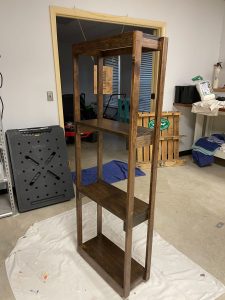This past weekend, I decided to do an art project by building a plant stand from scratch with my uncle Kirk. The process took a grand total of four days to complete, but it was well worth it to have a new piece of furniture. After designing the plant stand, we both decided to use reclaimed wood that Kirk had gathered over the past couple of years. Using the reclaimed wood was seen as a way to decrease deforestation and reduce landfill waste that had accumulated over time (Elemental Green).
The reclaimed wood we used does not contain as many harmful toxins that can enter the atmosphere as normal store-bought wood. Similarly, reclaimed wood is more durable in accordance to the Janka hardness scale than regular wood because it is used from older grown trees instead of more recently grown trees (Elemental Green). Another benefit of using reclaimed wood is that the wood looks aged, which is a bonus for someone, such as myself, who likes the antique aesthetic!
After the plant stand was cut into each of its separate pieces, Kirk and I stained the wood and let it dry for about 24 hours. The stain color I used was called espresso, which is a dark brown color. To also reduce the use of emitting toxic chemicals such as volatile organic compounds (VOCs), we used an environmentally friendly brand called ECOS Paints. Their paint stains use non-toxic chemicals so that people with health problems can be physically and environmentally safe. VOCs are similar to what is typically in paint stains that cause health problems and emission of petroleum air pollution, so using ECOS Paints was more sustainable to use on the reclaimed wood (ECOS Paints).
The most tedious process of making the plant stand was coating the stained wood four times with water based polyurethane, which is a more environmentally safe way to make the plant stand waterproof and have a shiny appearance. Water based polyurethane is better than oil based polyurethane because it does not emit high amounts of VOCs either. The oil based substance releases petroleum based carcinogens into the atmosphere, which yet again, causes severe health defects (Gemini Floor Services). On the other hand, oil based polyurethane is a very flammable substance, hence why the water based polyurethane is a better route to making a sufficiently waterproof plant stand. The water based polyurethane is a more durable substance because its compound has a “greater resistance to abrasion” (Gemini Floor Services). The water based polyurethane also dries faster than the oil based polyurethane because using more layers of thin coats is a more efficient way to assemble any piece of furniture quicker while releasing less chemicals into the air. Overall, the process of creating the plant stand with my uncle was a very enjoyable process while also being sustainable!
“The Advantages of Water Based Polyurethane Floor Finish.” Gemini Floor Services, 29 July 2019, www.geminifloors.com/the-advantages-of-water-based-polyurethane-floor-finish/.
“Why You Should Use Non-Toxic Wood Stain.” ECOS Paints, ECOS Paints, 29 July 2015, www.ecospaints.net/why-you-should-use-non-toxic-wood-stain.
“The Pros and Cons of Using Reclaimed Wood.” Elemental Green, 1 Mar. 2021, https://elemental.green/the-pros-and-cons-of-using-reclaimed-wood/.


